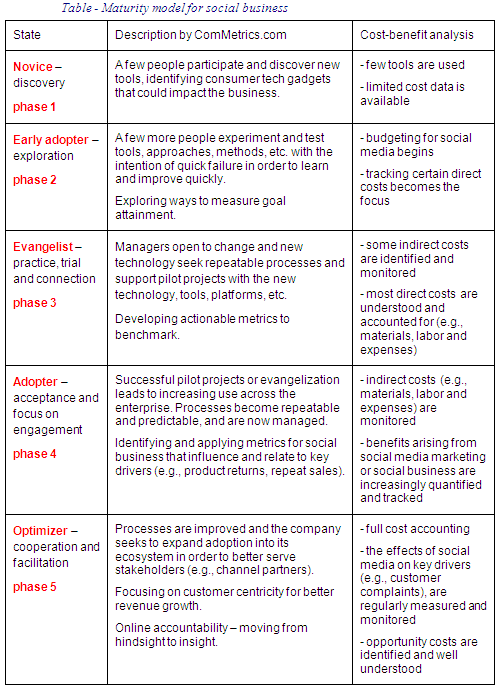Last week we launched a series of blog posts explaining the ComMetrics social media cost classification model. Using social media metrics, as well as tools for social media marketing and monitoring tools, posts are intended for social media strategists, corporate communications and social media marketing experts (see also Social Media DOs and DON’Ts).
This post is part of a series that addresses social media issues arising from increasing links between compensation for service providers and the value they generate for clients (pay-for-performance 2.0), in which cost-benefit issues, including ROI (return on investment), play a critical role.
Article source – Social business: The maturity model
Improve your cost management and subscribe to our blog posts, you’ll be glad you did!
- What is it?
A maturity model provides a systematic framework for carrying out benchmarking and performance improvements. It includes a series of descriptions of business performance for discrete business elements as shown in the table below.
The descriptions in our table below are ordered into levels of capability from Novice – Evangelist to Optimizer – cooperation and facilitation.
The optimum level of maturity is that which achieves the organization’s strategic objectives most effectively. Of course, this does not necessarily mean your organization’s objectives are best served by phase five.
- Why a maturity model?
The above table presents a model of the different stages companies go through with social media. Using the maturity model provides a better understanding of your organization’s current position. As the right-hand column indicates, the higher the level achieved, the more likely indirect costs are addressed to further support efforts undertaken to strengthen business processes.
Understanding the maturity model and knowing an organization’s unique position can help create a road map to reach the desired level of maturity, not for its own sake alone, but to effect different social media marketing outcomes resulting from varying phases of maturity.
The third blog post of the ComMetrics cost classification model for social media marketing series, entitled Developing a cost classification model for social media marketing will be published next week.
Stay tuned!
- Bottom line
Good cost accounting is at the core of proper social media management for any organization. It supports decision making and the effective allocation of scarce resources.
Our model allows you to ascertain where your organization stands and start taking the necessary steps to improve things further.
More resources
- – 2011 trends: The social media cost-benefit pyramid
– 2011 trendwatch webinar: More useless social media measures
In the meantime, how do you see it?
- 1. Which phase in the table best describes your business’ situation?
2. Which phase do most of your peers (companies in the same industry) fall into?
3. What is the best advice you were ever given about moving to the next phase?
4. What social media tool has made the biggest difference in your company’s efforts?
It is all about getting to know your customers to achieve better engagement in order to provide more value. Please leave a comment; the floor is yours!

Pingback: Urs E. Gattiker
Pingback: MyComMetrics
Pingback: CyTRAP
Pingback: Duncan Cowler
Pingback: JobShoots
Pingback: JobShoots
Pingback: Chris Isaac
Pingback: World Economic Forum
Pingback: World Economic Forum
Pingback: CyTRAP
Pingback: MyComMetrics
Pingback: Urs E. Gattiker
Pingback: Duncan Cowler
Pingback: Malaysian Brand
Pingback: Monej
Pingback: McCollins Media
Pingback: Malaysian
Pingback: Aziza
Pingback: shawna walker
Pingback: cleverdecoy
Pingback: Priit Kallas
Pingback: Nick Halliday
Pingback: Charles Zulli
Pingback: recipe for oatmeal chocolate chip cookies